| SILKYPIX® | SOFTWARE MANUAL |
| 4. Development Parameter Adjustment | ||||||||
Use the control window to adjust development parameters. By default, the control window appears at the left side of the screen. You can change its position to the right side with [Display Setting].
As a basic workflow, set the level of exposure bias and false color control with a slider first and then, select preset values of white balance, sharpness, tone, and saturation.
At the center of the control window, there are tabs for setting each item in detail. For example, when you select "Exp." tab, parameters to adjust exposure are displayed at the bottom of the control window, and you can make a precise setting of exposure.
- 4.1 Adjusting Development Parameter and Updating Preview
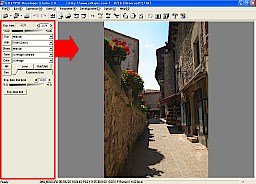 When the setting of each development parameter is changed, updating preview is performed automatically.
When the setting of each development parameter is changed, updating preview is performed automatically.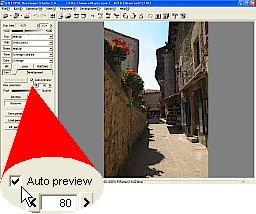 The software updates a preview automatically according to changes in parameter. However, if you want to give priority to comfortable operation (for example, a laptop with low power), you can change the setting to update a preview manually.
The software updates a preview automatically according to changes in parameter. However, if you want to give priority to comfortable operation (for example, a laptop with low power), you can change the setting to update a preview manually.To disable the automatic updating of a preview, uncheck the "Auto preview" checkbox in "Dev." tab.
You can also update a preview more speedily. See 'Speeding-Up the Updating Preview' for more detail.
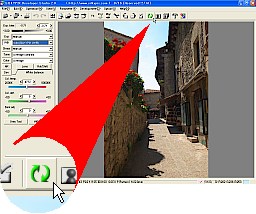 When the "Auto preview" checkbox in the "Dev." tab is unchecked, click the
When the "Auto preview" checkbox in the "Dev." tab is unchecked, click the  button to update a preview.
button to update a preview. *You can also update a preview by clicking the [Refresh preview] button in the "Dev." tab instead of the
 button.
button.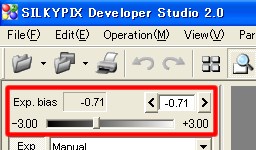 Exposure bias fixes a development gain at development process. This process is similar to the push and pull processing in film development, giving the similar result as with the exposure bias function used in cameras.
Exposure bias fixes a development gain at development process. This process is similar to the push and pull processing in film development, giving the similar result as with the exposure bias function used in cameras.Select the value with the "Exposure bias" slider or from the "Exp. bias " combo box to adjust the exposure bias.
You can take pictures on the condition that you can adjust with, so the software allows exposure adjustment at development process later. See 'Difference between Exposure Bias with Camera or at Development, and Application' for more detail.
4.3.1 Auto Exposure Bias
- Select the "Auto" in the "Exp." combo box when operating auto exposure bias.
With the highly advanced image processing based on our excellent technologies, SILKYPIX® Developer Studio's auto exposure bias algorithm detects an object, analyzes included colors precisely and allows the maximum level of color expressions on a display device or with a printing device while reducing over-exposure or color-change.
This feature reduces time to adjust development parameters and helps to create a picture with under exposure, which is peculiar to RAW data.
When setting auto exposure on a scene and copying its development parameters to the other scene, only the setting information (meaning that auto exposure is on) is copied,
and the exposure for the current scene is newly calculated. So, with this function, you can simply adjust all scenes automatically.
[---> Applying Auto Exposure Bias and Auto White Balance to Multiple Scenes]
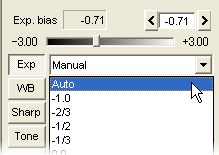 |
- The
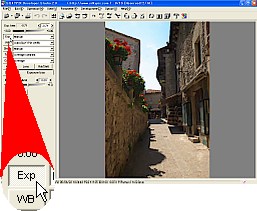 "Exp. bias fine tune" slider in the "Exp." tab helps you to adjust exposure in detail, which is impossible with the "Exp. bias" slider.
"Exp. bias fine tune" slider in the "Exp." tab helps you to adjust exposure in detail, which is impossible with the "Exp. bias" slider.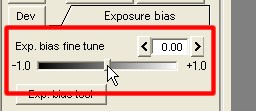 We recommend you to make rough adjustment with the "Exp. bias" combo box or "Exp. bias" slider, then to adjust in detail with "Exp. bias fine tune" slider.
We recommend you to make rough adjustment with the "Exp. bias" combo box or "Exp. bias" slider, then to adjust in detail with "Exp. bias fine tune" slider. 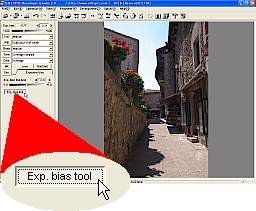 You can use "Exp. bias tool" to make the brightness of a specified point constant.
You can use "Exp. bias tool" to make the brightness of a specified point constant.Press the "Exp. bias tool" button on "Exp." tab to start the exposure bias point mode.
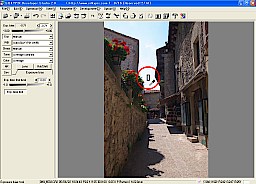 Then, click or drag the area in the photo to specify the range. The exposure bias value is set to change the brightness of that area to specified one.
Then, click or drag the area in the photo to specify the range. The exposure bias value is set to change the brightness of that area to specified one. Here, the brightness level means the photosensitive level on the RAW data. You can change it with the "Setting for exposure bias tool" in 'Function setting'.
This function works effectively even when a specified point is not achromatic color. In that case, the biggest value of R, G, or B is selected and set as the brightness level.
For example, when you click the red area, the exposure bias value that makes R as the brightness level is selected and calculated to execute the exposure bias.
*Instead of the "Exp. bias tool" button on the "Exp." tab, you can press the
 button to get the same result.
button to get the same result.*About eyedropper operation, see '9.3.8 Enable Continuous Operation of the Eyedropper Tool.'
- White Balance is the function to adjust white color.
Human eyes adjust to ambient light. We can perceive the white color of an object as white under the sunlight, lamps, and fluorescent lamps. In photos, however, while "white" under the sunlight can be expressed as white, white under the lamp is expressed as reddish white, and under the fluorescent lamp, expressed as greenish or bluish white.
What amends these color changes is white balance.
White balance adjustment vastly changes colors in photo and its impression. A white object in the photo can be expressed most beautifully and naturally with this function. In other words, the basic concept of white balance is expressing white as white.
However, it is not always true for all types of scene.
For example, if a white object in evening grow is expressed completely in white, you will not be able to know that it is a sunset scene. If you want to produce a melancholy mood on your picture in the clouded sky, it may be required to change to more bluish colors.
Although most cameras today can automatically adjust the white balance, it is not always correct, and even if it is correct, the result is not always what you really want. Therefore, it becomes necessary to adjust the white balance according to each expression.
However, it is very difficult to select and correct the white balance while you are taking a picture.
If you take a picture with RAW data, you can change the white balance as you want when you are developing a photo and select an appropriate expression for each scene. It is not so exaggerating to say that the greatest advantage of using the RAW data picture is this function.
4.4.1 Adjusting White Balance with Preset
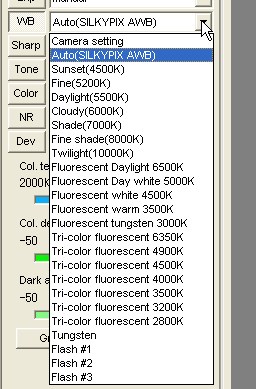 This is the way to make adjustment by selecting the white balance adjusted for each light source in advance.
This is the way to make adjustment by selecting the white balance adjusted for each light source in advance.Specify a light source in the "WB (preset white balance)" combo box.
You can also change settings in detail later, so it is convenient to select the light source first.
The preset items displayed in the preset combo box differs in each type of camera.
Here, general preset items are explained.
• Auto ... This auto white balance is based on an unique algorithm, which is completely different from the auto white balance function on cameras. The feature of this algorithm is that it can detect color of the light sources very accurately.
• Daylight ... White balance suitable for shooting outdoors
- Sunset ... White balance suitable for shooting in the direct sunlight of the evening grow
- Fine ... White balance suitable for shooting in the direct sunlight of daytime in fine weather
- Daylight ... White balance suitable for shooting in the direct sunlight in fine daytime (including obscured sky)
- Cloudy ... White balance suitable for shooting in scattered light from clouds in overcast day
- Shade ... White balance suitable for shooting objects in the shade in fine daytime (including obscured sky)
- Fine shade ... White balance suitable for shooting objects in the shade in clean and sunny daytime
• Fluorescent ... White balance suitable for shooting objects under fluorescent light
• Tri-color fluorescent... White balance suitable shooting objects under tri-color fluorescent light widely used in home
• Tungsten ... White balance suitable for shooting objects under incandescent lamp
• Flash... White balance suitable for shooting objects in the photoflash
- This function adjusts the white balance automatically. As previously mentioned, there is no right answer for the white balance.
It depends on what the photographer (you) want to express.
However, when you have to develop a lot of pictures, it is a difficult job to select appropriate white balance for each photo.
You have the auto white balance, which expresses a light source color in white automatically.
The method and logic of this auto white balance is fundamentally different from those used in cameras,
and allows very accurate detection of the white balance of high color saturation or an object having no white area, which typical auto white balance cannot handle well.
This white balance function will automatically adjust and reproduce the area that was white at the time this picture was taken.
Since this is the fundamental function of the white balance, set the auto white balance first, and then
adjust values out of the auto white balance manually. You can adjust the white balance quickly.
You can also set the white balance for all scenes at once.
[---> Applying Auto Exposure Bias and Auto White Balance to Multiple Scenes]
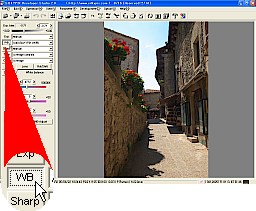 This is the way to adjust the white balance by specifying the color temperature.
This is the way to adjust the white balance by specifying the color temperature. When switching to the "WB" tab, the "Col. temp." adjustment slider appears.
 Move this slider to find the point where colors of the object are well balanced.
Move this slider to find the point where colors of the object are well balanced. When the color of the object is reddish or yellowish, move the slider to decrease the color temperature.
When the color of the object is bluish, move the slider to increase the color temperature.
 The "Col. def" slider is used to remove color cast. Before using it, adjust the color temperature first.
The "Col. def" slider is used to remove color cast. Before using it, adjust the color temperature first.When the color of the object appears green, move the slider to the + side.
When the color of the object appears magenta, move the slider to the - side.
See '13.1 Color Temperature and Color Deflection'
for your information.
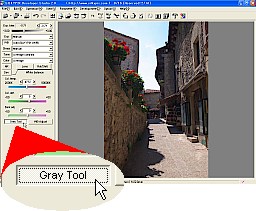 When pressing the "Gray Tool" on the "WB" tab, you can enter the gray point specification white balance adjustment mode.
When pressing the "Gray Tool" on the "WB" tab, you can enter the gray point specification white balance adjustment mode.Then, click or drag the area that you want to change gray to specify the range. The white balance will be set to express that area in gray.
When there is a gray object in a photo, you can easily adjust the white balance with this function.
Taking a picture of a gray chart or white paper in advance may become very helpful.
*Instead of choosing "Gray Tool" on "WB" tab, you can press the
 button to get the same result.
button to get the same result.*For eyedropper operation, see '9.3.8 Enable Continuous Operation of the Eyedropper Tool.'
 While color temperature and color deflection change the white balance of the whole image, the dark adjustment amends color cast of the dark area in the image.
While color temperature and color deflection change the white balance of the whole image, the dark adjustment amends color cast of the dark area in the image.In many cases, although the white balance of the bright area in a photo is well, in the dark area, green or magenta color cast occurs. With this function, removing color fluctuation from the dark area to the bright area, you can amend this kind of photo.
For example, the left picture shows a sample of strong magenta seepage in the dark area.
When looking a gray patch of Macbeth chart, you will find that the bright patch is well white balanced, but the color of the dark area becomes magenta. This affects the color of leaves (becoming yellow) and shadow (becoming red). With the dark adjustment function, the phenomenon caused by the white balance, which does not work for the dark area is drastically reduced. The right picture shows what happened on the same picture when magenta seepage is removed by the dark adjustment function.
[Detail of color cast in the dark area]
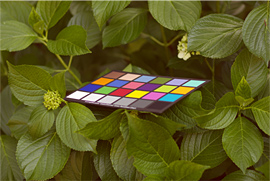 Without Correction | 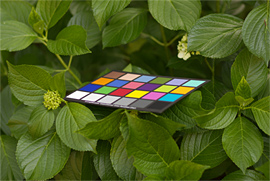 With Dark Adjustment (Value: -5) |
The main purpose of the function is to remove color cast in the dark area, however, with this function, you can also change the white balance of the dark area and bright area.
The left picture shows the status when photographing. The center shows the picture of which white balance is set as the "Fine" according to the area in the direct sunlight at the back in the photo. As you see, the color of the ground affected by the sun fleck becomes almost green. When changing the white balance of the ground in order to correct the color, the color of the area in the sunlight becomes magenta in turn. Therefore, only with the white balance you can't get the perfect effect for both of the ground and the area in the sunlight simultaneously. Actually, the color of the ground should be green because sun fleck is surely reflected to the ground, and the center picture shows the actual impression when photographing. However, human eyes adjust colors to match to what they want to see, so impression of the picture should be adjusted based on that. In such case, you should change the white balance of the dark area by using the dark adjustment actively. The right picture shows how the dark adjustment removes the green seepage of the ground without changing much of the color of the bright area in the sunlight. As you see, the impression has been improved.
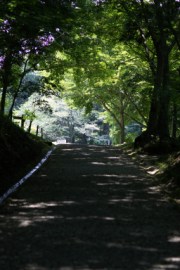 | 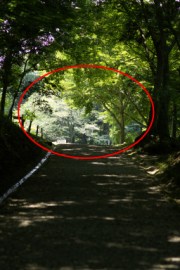 |
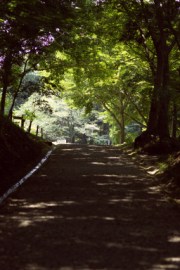 |
| Without Correction | With White Balance (Clear & Sunny) | With White Balance (Clear & sunny), Dark Adjustment (+6) |
Using both color temperature and color deflection as the situation demands
When changing the white balance, first decide the white balance of the bright area by the color temperature and color deflection. Then, adjust the dark area where you want to remove color cast with the dark adjustment function. The function works effectively on the dark area, but also affects slightly on the color of the bright area. Therefore, we recommend you to operate the dark adjustment and change the color deflection again to finish the job.
Detail of color cast in the dark area
Why does color cast occur in the dark area?
It is caused by leakage current of an image sensor. Because of the leakage current, the intense black is not recorded as 0 in RAW data. SILKYPIX® is subtracting such leakage current data from RAW data (optical black correction) to create an image. However, the leakage current of an image sensor becomes bigger as the temperature is getting higher, and vice versa. In most cases, a camera records black with constant level, regardless of the temperature, but some conditions or photographing environment may affect the level (optical black level). According to the color sensitivity of each image sensor, as the optical black level becomes larger, the color of the dark area becomes magenta, and as the level becomes smaller, the color becomes green. The dark adjustment function reduces coloring of the dark area in those cases. It also corrects the white balance of the dark area when a picture is taken under severe conditions such as extremely low temperature, high-sensitive filming, and long exposure.
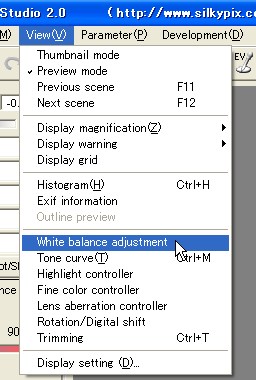 The menu [View(V)] - [WB Adjustment] displays "White balance adjustment" dialog of the white balance.
The menu [View(V)] - [WB Adjustment] displays "White balance adjustment" dialog of the white balance.Use this dialog when you want to change a little of the white balance at the last sequence.
With three controls including the white balance target, the "Sat" slider, and the "Hue" slider, you can change the settings more precisely.
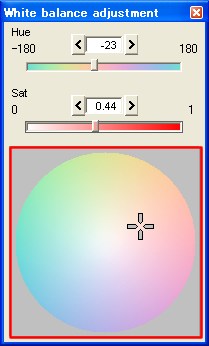 • White balance target
• White balance target- It is the specified area mapped and created based on the accurate color space. You can set the white balance viscerally by clicking a mouse directly.
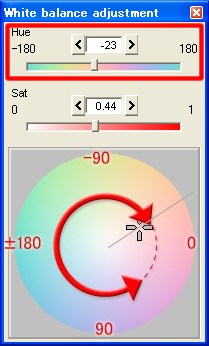 • "Hue" slider
• "Hue" slider- It shows the angle from the right hand side of the white balance in clockwise. Move the slider to change the angle in detail.
You can specify the setting value indicates:
| 0 | right from the center |
| 90 | downward from the center |
| 180 (-180) | left from the center |
| -90 | upward from the center |
| + | lower half from the center |
| - | upper half from the center |
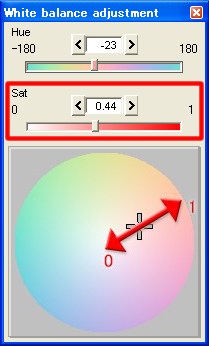 • "Sat" slider
• "Sat" slider- It shows the radius from the center of the white balance. Move the slider to change the radius in detail. The range is 0.00 to 1.00 (0.00 is the center of the white balance target, 1.00 is the maximum radius).
- We will introduce you some setting samples to show how to set to get colors you want.
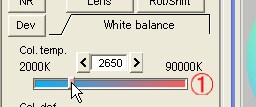 1) To remove reddish color (red seepage)
1) To remove reddish color (red seepage)- (1) Move the "Col. temp." slider to the smaller (lower) side.
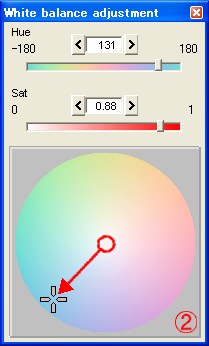 (2) With the white balance target in the "White balance adjustment" dialog, move the cursor to the opposite (blue) direction.
(2) With the white balance target in the "White balance adjustment" dialog, move the cursor to the opposite (blue) direction. 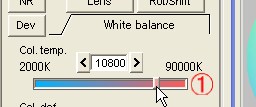 2) To remove bluish color (blue seepage)
2) To remove bluish color (blue seepage)- (1) Move the "Col. temp." slider to the larger (higher) side.
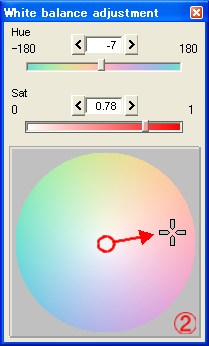 (2) With the white balance target in the "White balance adjustment" dialog, move the cursor to the opposite (red) direction.
(2) With the white balance target in the "White balance adjustment" dialog, move the cursor to the opposite (red) direction.  3) To remove purplish color (magenta seepage)
3) To remove purplish color (magenta seepage)- (1) Move the "Col. def." slider to the - side.
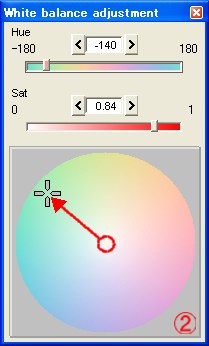 (2) With the white balance target in the "White balance adjustment" dialog, move the cursor to the opposite (green) direction.
(2) With the white balance target in the "White balance adjustment" dialog, move the cursor to the opposite (green) direction.  4) To remove greenish color (green seepage)
4) To remove greenish color (green seepage)- (1) Move the "Col. def." slider to the + side.
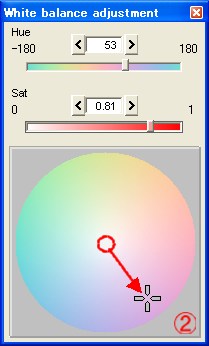 (2) With the white balance target in the "White balance adjustment" dialog, move the cursor to the opposite (purple) direction.
(2) With the white balance target in the "White balance adjustment" dialog, move the cursor to the opposite (purple) direction. - The sharpness function emphasizes the outline of an image. As the sharpness is stronger, the resolution increases more.
However, too strong sharpness sometimes makes the outlines white, black or opposite color.
Refer to the printing result to set appropriate level.
The high level of sharpness emphasizes noise at the same time, so it is also important to keep balance between noise level and sharpness level.
4.5.1 Adjusting Sharpness with Preset
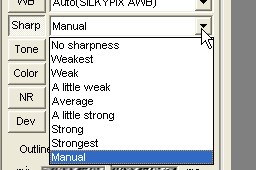 Select the level of the sharpness from the "Sharp (preset sharpness)" combo box.
Select the level of the sharpness from the "Sharp (preset sharpness)" combo box.You can select from 8 levels ("No sharpness" to "Strongest").
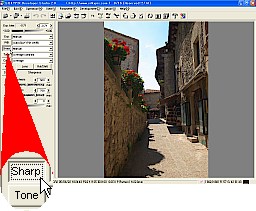 The sharpness adjustment of the software eliminates the outline phenomenon or noise occurrence mentioned above.
The sharpness adjustment of the software eliminates the outline phenomenon or noise occurrence mentioned above.The preset value provides you the parameters balanced well, but you can also set them manually to make more precise adjustments.
When switching to "Sharp." tab, three sliders appear. The details are explained below.
See also '10.9 Creating Extremely Clear Image' to make complete adjustment for sharpness setting.
(1) Outline emphasis
 Use it to fix the overall level of the sharpness.
Use it to fix the overall level of the sharpness. Use it to fix the emphasis level of fine edge (detail).
Use it to fix the emphasis level of fine edge (detail).When increasing this parameter, you can improve resolution of the detail without emphasizing outline.
However, this function emphasizes noise at the same time, keep balance with noise level.
*Detail emphasis level changes according to both of (1) outline emphasis parameters and this parameter. When decreasing (1) outline emphasis, detail emphasis also becomes smaller at the same time. At first, make rough adjustments by (1) outline emphasis parameter and then, adjust with this parameter.
 Use this to adjust the level to control false black or opposite coloring which appearing around the outline when the sharpness is increased.
Use this to adjust the level to control false black or opposite coloring which appearing around the outline when the sharpness is increased. However, when this parameter is increased, color separation doesn't work well (The color in the color boundary between different colors is lost and the area becomes white).
Keep this parameter and the color separation in balance.
- Tone adjustment parameter adjusts the contrast, high or low.
4.6.1 Adjusting Tone with Preset
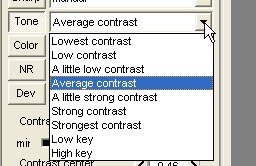 Select a tone level in the "Tone (preset tone)" combo box.
Select a tone level in the "Tone (preset tone)" combo box.You can select a level from 9 levels ("Lowest contrast" to "Strongest contrast," "Low key",and "High key").
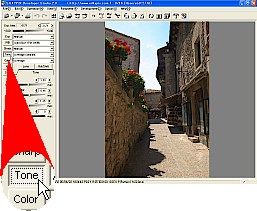 Tone adjustment can be changed with "Contrast", "Contrast center", and "Gamma."
Tone adjustment can be changed with "Contrast", "Contrast center", and "Gamma." By preset, these parameters are fixed based on the condition at filming of average object with appropriate exposure (or with correct adjustment by the exposure bias), but you can also set them manually to make more precise adjustments.
Switching to the "Tone" tab, three sliders appear. The details of parameters are shown below.
(1) Contrast
 Contrast means the distinction between bright area and dark area.
Contrast means the distinction between bright area and dark area.When increasing the contrast, the bright area becomes brighter and the dark area becomes darker, i.e. high contrast.
On the contrary, when decreasing the contrast, difference between the bright area and dark area becomes smaller, i.e. low contrast.
 This is the reference to judge the brightness when adjusting the contrast. Upper from the contrast center is considered as bright, and lower is considered as dark.
In other words, this reference decides the point where the brightness level is not changed when adjusting the contrast.
This is the reference to judge the brightness when adjusting the contrast. Upper from the contrast center is considered as bright, and lower is considered as dark.
In other words, this reference decides the point where the brightness level is not changed when adjusting the contrast.When setting the contrast center smaller, you feel the tone of an image becomes lighter.
This is because the contrast is increased based on the dark area, and causes the dark area to turn smaller and the bright area larger.
On the contrary, when setting the contrast center bigger, you feel that the tone of the image becomes darker.
Increasing the contrast means compressing the gray scale of bright area and dark area and expanding the gray scale around the contrast center.
Therefore, if a target object is dark, set the contrast center smaller, and if it is bright, set the contrast center bigger to get the ideal tone.
The contrast center is displayed on the "Histogram." When you move the cursor to the position on the photo currently displayed in the preview screen while histogram is displayed, the brightness of R, G, and B on that point is displayed. With this function, make adjustments, looking the brightness distribution on the area you want to add contrast, and you can find the appropriate level relatively easily.
 Gamma is brightness adjustment. As the gamma is larger, the overall brightness becomes higher, and vice versa.
Gamma is brightness adjustment. As the gamma is larger, the overall brightness becomes higher, and vice versa.You may think it is the same as exposure bias operation, however, they are not the same thing.
With the exposure bias, the brightness is adjusted without changing the ratio of bright area and dark area. On the contrary, with gamma, the ratio is changed.
When increasing the gamma value, the bright area is compressed, and the dark area is expanded.
When decreasing the gamma value, the dark area is compressed and the bright area is expanded.
Therefore, in this software, this operation is considered as tone-change-operation and classified as 'Tone Adjustment' since it changes tone.
As just described, operation to increase the contrast compresses both bright area and dark area and expands the area with the intermediate range of brightness.
This means an object with the intermediate range of brightness is expressed in the much of a gap between brightness and darkness.
"Contrast center" fixes the intermediate range of brightness.
 Black level controls clear expression of the dark area.
Black level controls clear expression of the dark area.You can specify the level of black with this function. When increasing this parameter, the color black becomes deeper black.
This function works effectively when a picture is taken against the sun and the image becomes unimpressive, or when a landscape image becomes grayish, influenced by irregular reflection of air.
- You can select and adjust saturation, color mode, and colorspace.
4.7.1 Adjusting Saturation with Preset
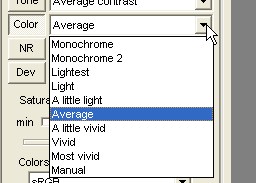 Select saturation in "Saturation (preset saturation)" combo box.
Select saturation in "Saturation (preset saturation)" combo box.7 levels ("Lightest" to "Most vivid") and 2 types of monochrome are selectable.
The "Lightest" level makes the color pale and the "Most vivid" level makes the color brightest.
When increasing the saturation level, colors become brighter, however, the detail of the area having vivid colors may be lost because of too much saturation.
Therefore, when adjusting saturation, you have to check the overall brightness of colors and lost of detail.
Select "Monochrome" or "Monochrome 2" to create a monochrome picture.
Monochrome 2 can create a natural-looking monochrome picture that has more similar sensitivity characteristics to human eyes than Monochrome.
Select the appropriate mode for your picture according to the scene.
Use the final color image at the last sequence to create a monochrome picture.
You will be able to create various monochrome pictures by changing the white balance and color mode.
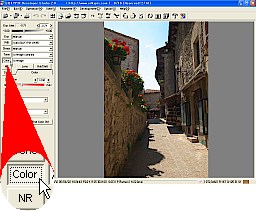 The presets include the range of saturation that is considered to be used normally. However, if you want more or less saturation, or adjust saturation more precisely, you can set manually.
The presets include the range of saturation that is considered to be used normally. However, if you want more or less saturation, or adjust saturation more precisely, you can set manually. In the preset combo box, switch to the manual setting first and then make adjustments in detail with the slider in the "Color" tab.
 Select colorspace in "Colorspace" combo box in "Color" tab to decide the tone expression at development, colorspace for working adjusted by the tone curve, and colorspace for image file created after development.
Select colorspace in "Colorspace" combo box in "Color" tab to decide the tone expression at development, colorspace for working adjusted by the tone curve, and colorspace for image file created after development.You can select "sRGB" or "adobeRGB."
sRGB is the standard colorspace for Windows. Since Windows handles sRGB colorspace by default, use the software with the sRGB setting generally.
adobeRGB is effective in processing the image, which was developed by this software, with a photo retouching software additionally, or in printing purpose.
It has wider color reproduction range than sRGB, but cannot be operated unless you have proper image processing environment to handle color profile (improper environment generates strange colors).
When reading files output by adobeRGB with other software, set adobeRGB colorspace for the profile setting (Operation varies depending on each software, so refer to the manual of the software you are using).
This software also enables to embed a color profile indicating the colorspace into an output file. A file with an embedded profile allows transferring the colorspace to the software supporting the color profile.
In addition, this software complies with Exif 2.21 Specification and outputs Exif information indicating adobeRGB colorspace.
See 'Setting for Developed Image' for embedding profile or Exif information output.
* When selecting adobeRGB, preview is displayed based on adobeRGB colorspace. Therefore, when the color management of monitor is not set, colors are displayed differently.
When selecting adobeRGB, set the color management of monitor valid so that the correct colors are displayed.-->See '9.2.1 Color Management'.
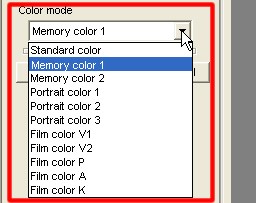 The color mode sets orientation of color reproduction. Select a mode in the "Color mode" combo box in the "Color" tab.
The color mode sets orientation of color reproduction. Select a mode in the "Color mode" combo box in the "Color" tab.There are "Standard color", "Memory color", "Portrait color", and "Film color" in the color mode.
4.7.4.1 Standard Color
- This is the standard color creation of SILKYPIX®, which is aiming at true color reproduction.
This mode provides reasonable natural colors for many scenes.
- True colors in photo are not always "beautiful colors."
It is common knowledge that colors in our memory, or colors of an object that we want are different from actual colors. Although they differ in individuals, we can find a constant trend and directional character.
We consider the picture "beautiful" when colors in our memory or colors we want to see are printed in the photo.
This mode creates colors of such memory color or colors ordinary people want to see.
Although the directional character is different for each color, in short, saturation tends to be high, and the saturation level is higher than the "Standard color" mode.
This mode provides "beautiful color photo" for many scenes, but colors of some objects with high saturation such as flowers become too vivid and changed wrongly.
In such case, adjust with '4.11 Fine Color Controller', set lower saturation level or lower development gain to correct the color.
Memory color 1 performs the same color reproduction as "memory color 1" in the previous version of the software. Memory color 2 provides human-oriented touch of memory color with the new color reproduction technology "3-dimentional color mapping method."
Select the mode as you like.
*When decreasing the development gain to express images darkly, it becomes easier to reproduce the color of object with high saturation. This is because most display devices (such as a display) and printing devices (such as a printer) are not good at outputting high saturation and brightness simultaneously.
This mode is not effective in a portrait photo.
Skin color is kind of orange and recorded with high saturation. Therefore, it is reproduced in high saturation with this mode, but every models or photographer does not want high saturation output for skin color.
If you want to emphasis the highlights of the skin, select "Portrait color" in the color mode.
- "Portrait color" is color reproduction, which emphasis the tone and is better suited for photographing a person.
When this mode is not appropriate when taking a picture, use the "Standard color."
Portrait color 2 is a mode that highlights the skin color with new color reproduction technology "3-dimentional color mapping method", which differents from Portrait color 1.
Portrait color 3 highlights the color of clothes and background slightly shifted from the "memory color" based on "Portrait color 2."
Use these color modes according to your preference.
- This mode provides color reproduction similar to reversal film.
In film, a light source or exposure impacts on colors, which is different from digital camera. If you want a nice color with film, the color of light source and exposure range are limited.
Since this limitation reduces the advantage of digital camera, we have adjusted each parameter to realize all adjustment functions including the white balance or exposure bias and film tone colors simultaneously.
Therefore, you can get the film-like color easily when you select this "Film color" in the "Color mode."
However, the tone of gray axis does not change only by changing this mode. Adjust the tone, too, if required.
Since the film tone mode (for example, vivid film tone V) makes saturation high, colors in that mode changes according to the white balance adjustment.
In the "WB" tab, adjust the white balance to create your favorite colors if needed.
4.11 Fine Color Controller allows more precise color adjustment.
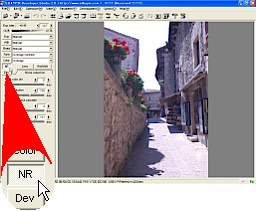 Noise means the rough texture that occurs in high sensitive filming. We call it high frequency noise in the software.
Noise means the rough texture that occurs in high sensitive filming. We call it high frequency noise in the software.At the high sensitive filming, red, green, or blue spots appear, too. We call them color noise in this software.
The function to remove such noise is the noise reduction.
In this software, the noise reduction function has independent parameter for each category.
The following sections are summaries of the function of noise reduction.
4.8.1 False Color Control
 The false color control function changes the process level of false color reduction.
The false color control function changes the process level of false color reduction.The software enables to reduce both false colors occur in the fine structure area (high frequency area) and color noise.
When too much color noise at high sensitive filming or false colors in the fine structure area occur, increases the reduction level.
However, there are some demerits in this function.
As the reduction level becomes stronger, the color separation level goes down, which makes colors in the color boundary blur. Also, there is a problem of "color spill," which is the phenomenon that occurs when the vivid color leaks around the picture.
Therefore, too strong reduction level may decrease the picture quality.
 Use the "Noise reduction" slider in the "NR" tab to reduce the high frequency noise. This function reduces the noise, with using RAW data.
Use the "Noise reduction" slider in the "NR" tab to reduce the high frequency noise. This function reduces the noise, with using RAW data.Also, you can remove noise that often occurs when the sharpness is increased. Use the "Noise level" and the "Noise cancel" in the "NR" tab.
See '10.9 Creating Extremely Clear Image' for the operation.
- Color noise is false color, which is generated by noise, and often appears at high sensitive filming. Use the false color control function to modify.
To reduce false colors around the outline, which appear at the time of adjusting sharpness (it is not the noise, though), use the "false outline ctrl."
4.8.3.1 Noise Level
 Fix the level of outline for outline emphasis with this parameter. The sharpness adjustment of this software only works toward the outlines above the setting of the noise level, and not effective for the outline or noise under that level.
Fix the level of outline for outline emphasis with this parameter. The sharpness adjustment of this software only works toward the outlines above the setting of the noise level, and not effective for the outline or noise under that level.Therefore, increasing this parameter may remove the noise, which is too noticeable.
However, as it becomes higher, the resolution especially in the detail becomes lower.
If you want to increase the resolution in the detail, set the lower noise level.
 Specify the level to cancel the noise which is under the noise level set with the noise level function.
Specify the level to cancel the noise which is under the noise level set with the noise level function.*If too much rough texture is seen in a photo, we recommend you to make the level higher to modify.
- The "
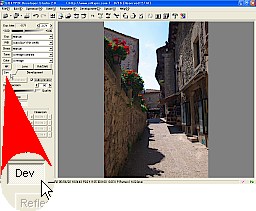 Dev. precision" in the "Dev." tab fixes the development quality.
Dev. precision" in the "Dev." tab fixes the development quality.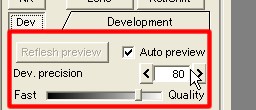 Normally, set this value around "80."
Normally, set this value around "80."Set it lower for a picture with full of noise. See 'Relation between Development Precision and Picture Quality' for more information.
You can change it temporary in order to speed up preview display. See 'Speeding-Up of Updating Preview' for your reference.
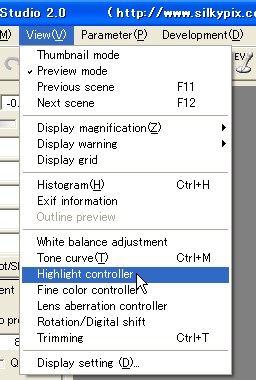 Highlight controller function controls color creation in highlight area.
Highlight controller function controls color creation in highlight area.The menu [View(V)] - [Highlight controller] displays the "Highlight controller" dialog.
This function controls a color clip in the highlight area, where one of color components (R, G, or B) is saturated. There are several types of controls. The "Saturation/Tone" and the Saturation/Hue" controls impact on the area where at least one of color components is saturated. The "Restoration" control restores the lightness of the area with under exposure bias adjustment that was purely saturated when photography.
4.10.1 Emphasis on Saturation/Tone
- Saturation/Tone controls the priority of saturation or tone to create colors in the highlight area.
The following pictures were developed based on the RAW data with highlight area (flowers). They were developed with saturation, tone, or intermediate between Saturation/Tone.
"Saturation" emphasizes the colors of the flowers, and "Tone" controls the highlight area effectively to express the glare of the reflected light.
 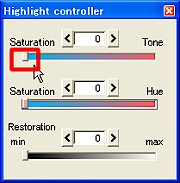 Saturation (value: 0) |  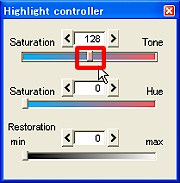 Intermediate (value: 128) |  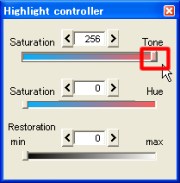 Tone (value: 256) |
Here is another sample.
"Highlight controller" works effectively with the lighter area such as the sunset scene.
The following pictures, which are sunset scenes, were developed with each priority, saturation, tone, and intermediate between them.
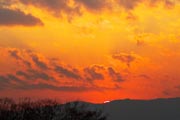 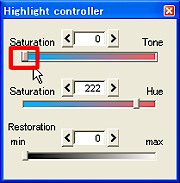 Saturation (value: 0) | 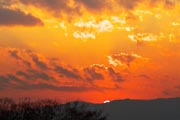 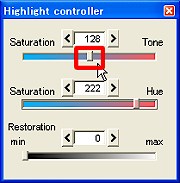 Intermediate (value: 128) | 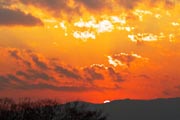 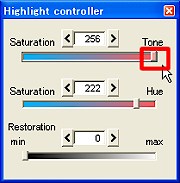 Tone (value: 256) |
- After giving priority to saturation with the "Saturation/Tone" slider, you can also control the priority of saturation or hue to finish development process.
As shown below, since R value (red) of the orange flower in orange was saturated, the hue of the highlight area became yellowish.
In such case, emphasize the hue with the "Saturation/Hue" slider to prevent reverse of the hue.
This process is also effective for the highlight area of skin, which has become yellow.
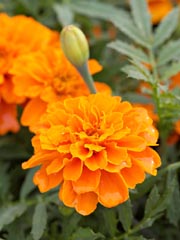 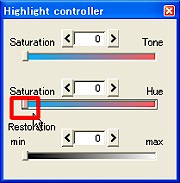 Saturation (value: 0) | 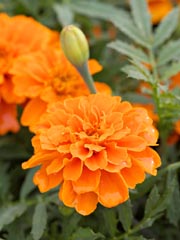 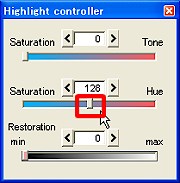 Intermediate (value: 128) | 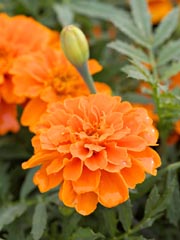 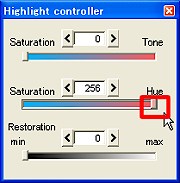 Tone (value: 256) |
In some cases, it is more helpful to give priority to saturation.
In the following picture (a bee and a flower), you can see the color of pink and yellow are nicely reproduced by putting priority on saturation.
  Saturation (value:0) |   Intermediate (value: 128) |   Tone (value: 256) |
- This function restores original colors, which were lost by over-exposure at filming.
In RAW data, the color information may be recorded correctly even though it is lost on the photo.
In such case, make the exposure bias under at the development and you can restore the tones recorded in RAW data.
However, the area where the sensor is saturated cannot be restored with this way. Restoration enables to restore the lost lightness information based on information provided with a sensor with lower sensitivity.
The left is a picture of RAW data, which was taken with exposure set to the trees and ground and developed without exposure bias. The center picture was developed with -2EV exposure bias. The tones of the sky and clouds were restored and you can check lens flare. The right picture was restored by restoration.
As you see, the sky and clouds become clearer with this operation.
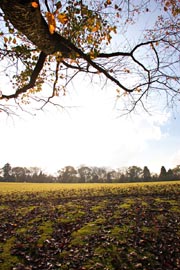 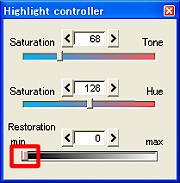 Restoration(value: 0), No Exposure Bias | 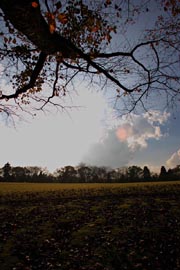  Restoration(value: 0), Exposure Bias-2.0 | 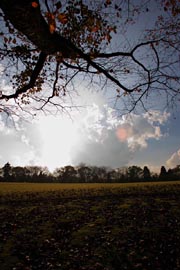 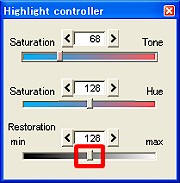 Restoration(value: 128), Exposure Bias-2.0 |
In addition, the following example is created with the image combine of the upper left picture and the sky and clouds in the right picture.
This shows the best result with the restored sky and clouds, and appropriate exposure on the trees and ground. This sample takes full advantage of development based on RAW data.
When you create two types of developed pictures with different exposure bias and restoration parameters, and combine them with a photo-retouching software, you can operate such wide dynamic range and create a nice photo. This is the excellent advantage of RAW data.
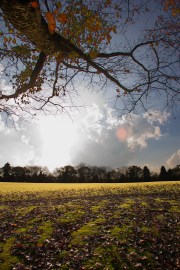 Composite Picture |
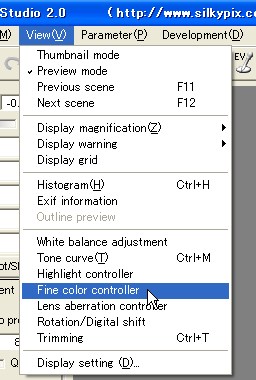 Fine color controller is a powerful tone adjustment function enabling to handle colors freely.
Fine color controller is a powerful tone adjustment function enabling to handle colors freely.The menu [View(V)] - [Fine color controller] displays the "Fine color controller" dialog.
Move 8 points displayed on the control to handle colors.
The control displays all colors of all hue. Colors far from the center of the circle have high saturation.
This is a cross-sectional diagram uniform colorspace, where the colors are allocated as equal as possible to match human sense.
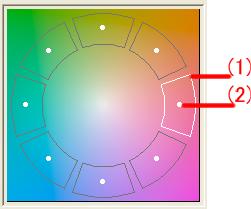 Fine Color Control |
In this control, there are 8 operation points inside. Move these points to adjust colors.
You can drag the operation point near the target color with mouse to change saturation or hue. The sliders are also available for changing hue, saturation and lightness.
As you move the operation point to outside of the color circle, the saturation level becomes higher, and as you move the point inside, the level becomes lower.
You can change the hue by moving the point on the circumference of the color circle.
The selected point can be adjusted precisely with the slider above. You can change not only the hue and saturation, but also lightness with the slider.
You can change colors you want with this function. There is no special theory.
Use this control repeatedly to master the operation.
We recommend you to set the white balance, exposure and color mode before using this control.
When you changed the white balance to make the skin pinkish, and that operation caused the sky becoming purplish, you can change the hue of the purplish point to make the sky blue.
Also, you can change the color of the skin and sky with the moderate white balance first. Next, adjust the orange point to change the skin color to the level you want, and then change the color of the sky.
You may want to change colors uniquely on purpose, like making a red tulip a pink one, or changing purple to blue purple. Enjoy color variation and make your inspired vision a reality.
When you feel confused with such variety of options, select the color mode to create colors closer to your favorite ones first, and make fine adjustments.
The important feature of this function is modification of over-exposure in the high saturation area.
Especially when you try high saturation photo with the memory color or film tone V, the over-exposure occurs in the high saturation area.
In this case, decrease the level of saturation or lightness of the color to reduce this phenomenon. See '10.6 Modification of Overexposure' for more detail.
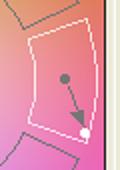 |
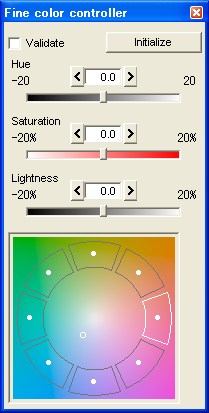 Adjusting with the sliders
Adjusting with the sliders - "Hue": Set the angle in anticlockwise rotation from the reference point.
"Saturation": Set the ratio assuming that the distance from the center of the color circle to the reference point is 100%. When setting -20%, the operation point moves to the inside by 20%, and the saturation level is decreased. When setting 20%, the point moves to the outside by 20% and the saturation level is increased.
"Lightness": Set the ratio assuming that the lightness of the reference point is 100%. When setting -20%, the lightness level is decreased, and setting 20%, it is increased.
"Initialize" button: Return all points to the initial state.
"Validate" checkbox: Validate the fine color control.
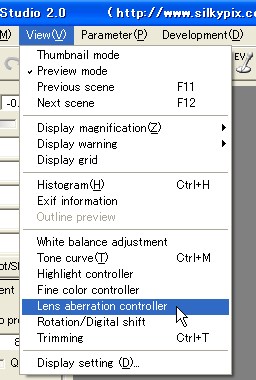 Lens aberration controller is a function to correct lens aberration at development in order to create high quality image.
Lens aberration controller is a function to correct lens aberration at development in order to create high quality image.The menu [View(V)] - [Lens aberration controller] displays the "lens aberration controller" dialog.
Photo lenses have aberration. Today, the resolution of digital camera is improved, therefore, lens aberration may have a damaging effect on the picture quality. There are various kinds of lens aberration such as spherical aberration, coma aberration, astigmatism, curved field, distortion aberration, axial chromatic aberration, chromatic aberration of magnification, and shading reduction that is a decrease of light volume occurring in the periphery. To adjust these aberration three corrections are available:
shading, distortion, and chromatic aberration.
4.12.1 Shading (Peripheral Brightness) Correction
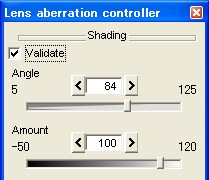 Shading correction is a function to correct light falloff at edges, which is a characteristic of a lens, making an area around the object darker. Use two parameters to correct shading.
Shading correction is a function to correct light falloff at edges, which is a characteristic of a lens, making an area around the object darker. Use two parameters to correct shading. 4.12.1.1 Angle (degree)
- Input the diagonal angle of the view of the lens when photographing.
On lens, light volume is decreasing toward the periphery area. The light volume is larger in a wide-angle lens and smaller in a telescopic lens. Based on conversion to 35mm film (full digital size single-lens), the angle of 50mm standard lens is approximately 46degree, 135mm telescopic lens is approximately 18degree and 35mm wide-angle lens is approximately 63degree. When you input the angle of view, the shading level is calculated according to the design logic of lens for correction.
However, it does not always match the actual shading when photographing (See 'Detail of Shading Reduction'), please move the slider and find the best point using the value mentioned above.
- Input the ratio which you apply for the correction.
When you set the amount 0%, no correction is performed, and the amount 100%, the logical value calculated based on the angle is used. You can set the parameter up to 120%.
You can use this function to adjust the level of correction for the following cases. The case you want to remain the shading effect without complete correction since the shading is one of the effects which is unique to a lens. Or a case that a bright object is on the periphery of a photo and it is lost when you make corrections.
You can also increase the shading level by setting minus value. Use the value to emphasize the center area on purpose by darkening the periphery, or to make the background quiet.
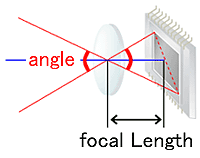 |
- When image formation is distorted, it becomes lighter as the object is distorted.
For example, fish-eye lens distorts the object in the periphery to be smaller to prevent shading reduction.
Also, the aperture of a certain type of lens seems to be smaller than actual when viewing at a slant (vignetting), and such lens causes larger amount of shading in the periphery area than the logical features.
Focus level also impacts on the shading level. When it is opened, large amount of shading appear, and when it is focused, shading amount becomes smaller. Moreover, with a digital camera, grazing incidence to the image sensor causes shading.
Therefore, handle the angle of view only for your reference. Find the best balanced point by yourself. It is helpful to understand that correction volume becomes smaller and correction between the center and periphery becomes linear when making the angle parameter smaller, and correction volume becomes larger especially in the periphery when making the angle parameter bigger.
When you find that the overall image is corrected well except the periphery area, make the parameter bigger to increase the correction level in the periphery. When the relation between the overall image and periphery is contrary, make the parameter smaller.
- Distortion correction is a function to correct distortion aberration, making the straight line distorted. Before using this function, check the "Validate" checkbox.
4.12.2.1 Distortion Rate
- See the right picture. When the image is distorted like a barrel, move the slider to the left to set minus value. Adjust the parameter with the slider to the point that the distorted line becomes a straight. If the image is distorted like a bobbin, shown in the left picture, move the slider to the right to find the best point. If the slider stays at the center 0, no correction is performed. After the correction, you can compare the original image with the corrected image by checking and unchecking the "Validate" checkbox.
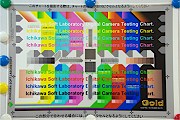 Bobbin Shape | 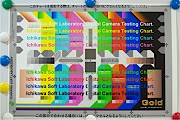 After Correction | 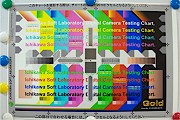 Barrel Shape |
4.12.2.2 Center/Edge Control
- Determine which one should control first, the center or edge to make distortion adjustment.
If the correction level is so strong that the image around the center becomes distorted even though the straight line at the corner is corrected well, move the slider to select the center priority. If the level is too weak move the slider to an opposite side. The left picture shows the pillar was distorted because of lens distortion aberration. The right picture was created by correcting the left picture to make the pillar straight.
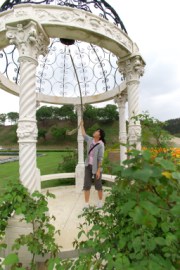 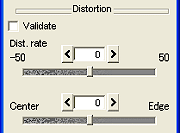 Original | 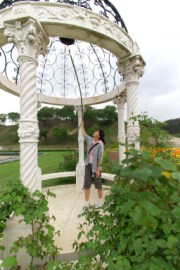 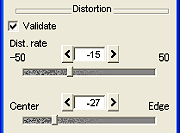 After Correction (Amount: -15 Center/Edge: -27) |
Repeat adjustments of this parameter and distortion rate in turn to correct most of distortion of photo lenses, which can be corrected almost completely. If you use this parameter properly, it is possible to correct or modify a lens having complicated distortion aberration (called hat shape type).
Although the distortion adjustment function was originally created for correcting lens distortion aberration, you can utilize it variously. For example, you can modify a phenomenon that objects are printed in all directions in the periphery of wide-angle lens by emphasizing perspective or increasing distortion level. The process in this function is not a simple distortion correction often used in a photo retouching software. This is a special process simulating a real lens aberration based on the actual design of a photo lens.
The right picture below was created with the stronger distortion level than usual. In the left picture (the original), the bubble and faces are distorted because of distortion aberration. The distortion level in the right picture was so strong that the shapes of the objects were distorted, that has given them more natural looking.
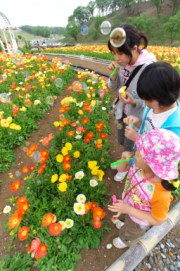 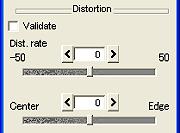 The Original | 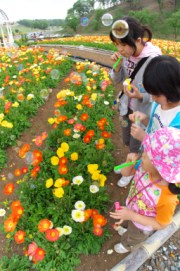 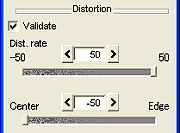 After Correction (Amount: 50 Center/Edge: -50) |
You now have got the effect of the lens, which can change its distortion level freely. Enjoy various combination of parameters, and find a new expression.
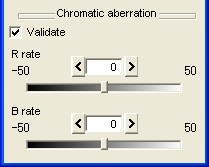 Chromatic aberration correction is a function to correct false coloring on the edge around an image, which is a characteristic of lens.
Chromatic aberration correction is a function to correct false coloring on the edge around an image, which is a characteristic of lens. Chromatic aberration is caused by the difference in image formation ratio of light (red light, green light, and blue light) incoming to a lens.
Chromatic aberration correction is performed by changing R image formation ratio and B image formation ratio slightly. First, enlarge the area, where the edge of periphery is colored, to more than 400%, and display it (See '[Reason to enlarge more than 400% and selecting edge for proper correction]'). Then, decrease the false color control in the "NR" tab (for example, 0 - 80). After that, check the "Validate" checkbox to adjust the R rate and the B rate.
When you correct a picture, enlarge the periphery area as shown below to check the correction result and change parameters.
4.12.3.1 R Rate
- This adjusts the image formation ratio of red light. If the edge is colored by red or cyan (complimentary color of red), change this parameter first.
- This adjusts the image formation ratio of blue light. If the edge is colored by blue or yellow (complimentary color of blue), change this parameter first.
When these two parameters are appropriate, coloring is decreased most.
First, look the edge condition and change the R rate so that "red <--> cyan" in the both sides of edge is decreased. Then change the B rate to adjust "blue <--> yellow" coloring. Repeat the R rate and B rate adjustments to find the best point.
Do not try to decrease coloring, but try to distribute the edge coloring uniformly. After that, when increasing the "False color ctrl" slider in the "NR" tab, the remaining colors are disappeared. Increase the parameter until you are satisfied, and finish adjustments.
At this time, if colors still remain even after the false color control is maximized, there is a possibility that chromatic aberration is so big that it excesses the correctable range or that coloring occurs because of aberration other than chromatic aberration. For example, too light background shows a possibility of coma aberration.
At the present time, aberration you can correct is only chromatic aberration. See also '[Reason to enlarge more than 400% and selecting edge for proper correction]' for your reference.
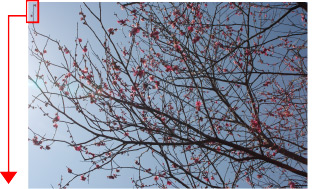 The Original Picture |
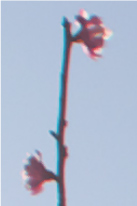 Before Correction |  | 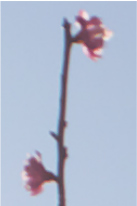 After Correction |
Enlarging preview with more than 400% stops simplified development and glare at the time of updating preview, so you can view images more easily. In chromatic aberration correction process, it is recommended to set the preview ratio with more than 400% in order to check changes in the image and to adjust parameters. If updating preview according to parameter changes is too slow to handle, increase the preview ratio more, or make the window for displaying updated preview smaller.
It is preferable to select the edge you want to change when enlarging a display for adjustments. Please pay attention to the following points.
- 1. Do not select edges in too light (white) background.
- The background of the sample is not lost, though, the tone of this picture is light and aberration appears in the twig against the background of the light sky. You should not select the point in such background for aberration correction. The white background is too shiny, and coloring is generated by not only chromatic aberration but also by other aberration such as coma aberration or astigmatism that make difficult to adjust parameters.
- Chromatic aberration appears because of difference between the ratios of image formation for each color. Therefore, it hardly appears on the radiate line or edge from the screen center and often appears on the orthogonal edge. Selecting orthogonal edge makes parameter adjustments easier.
- Chromatic aberration impacts most on the periphery around the image. Coloring is becoming stronger in the area far from the center of the image. Check the edge around the image to make adjustments.
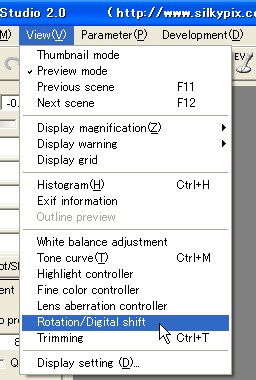 The menu [View(V)] - [Rotation/Digital shift] displays the "Rotation/Digital shift" dialog.
The menu [View(V)] - [Rotation/Digital shift] displays the "Rotation/Digital shift" dialog.4.13.1 Rotation
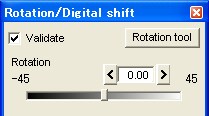 Rotation is a function to rotate an image.
Rotation is a function to rotate an image.With rotation function, a rectangle with the original image ratio is automatically trimmed to enlarge the size of the image to the original one. This process maintains the number of pixels after rotating when the image is developed, and prevents from resolution reduction after rotation.
Since this process prevents resolution reduction after rotating, you can use rotation function at ease. This function works well on a picture you took slightly at a slant.
This software allows -45degree to +45degree rotation. Too big rotation loses a large part of the image.
In this case, use the "expansion" in the trimming functions to display all pixels lost in the rotation process and you can extract the area you need. >See 'Expansion of trimming.'
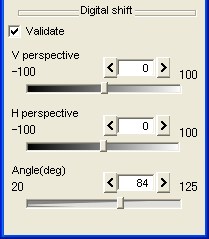 Digital shift enables deformation effect of the picture taken by a shift lens.
Digital shift enables deformation effect of the picture taken by a shift lens.As this function controls perspective, you can correct the narrowed upper area in the picture of buildings.
The "V perspective" slider can change the ratio for the upper area and lower area of the image. When moving it to the left (smaller value), the ratio for upper area becomes bigger, and to the right (big value), the ratio for lower area becomes bigger. The "H perspective" slider can change the ratio of the left and right of the image. When moving it to the left, the ratio for left area becomes bigger, and to the right, the ratio for the right area becomes bigger.
The image becomes a pedestal or distorted quadrangle after deformation, however, it is automatically trimmed based on the original image ratio to change the size of the original one. Therefore, the number of pixels is not changed after using this function when the image is developed, and resolution reduction cased by deformation is also avoided.
If you want the part lost with trimming, use "expansion" of the trimming function and display the all lost pixels by digital shift to extract required area. >See 'Expansion of trimming.'
Digital shift works not only on a picture of buildings, but also on various kinds of photo. As you see in the picture below, you can make a person's face smaller and legs longer. In this picture, +6 (down: fall) is set for digital shift to correct the original, and you see that the legs become longer in the corrected picture.
 The Original | 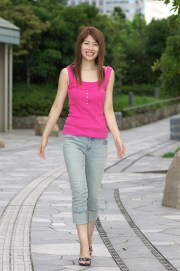 After Correction (V perspective: +6) |
The deformation of this process is not a simple conversion from rectangle to pedestal, but the projection conversion from three-dimensional space to two-dimensional space. The same type of conversion that is done when taking a picture of real three-dimensional objects with a camera is executed so that you can get the same effect of a shift lens.
You have now got the lens, which can shift freely. Try various combination of parameters to find a new expression.
Angle
- You will need angle information of a lens in order to get the right effect of digital shift.
The default angle parameter is set almost correctly based on the EXIF information of input file.
However, when you don't attach a manufacturer's lens or attach an old lens, the angle may not be set properly.
If you find that the image is distorted vertically or horizontally after the digital shift process, adjust the "angle" parameter.
Frequent use of the "angle" parameter gives an impression as if the aspect ratio with digital shift changes.
Use that effect as one of unique expressions.
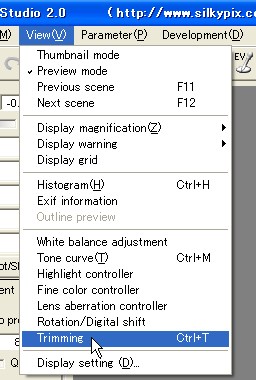 The menu [View(V)] - [Trimming] displays "Setting for trimming" dialog.
The menu [View(V)] - [Trimming] displays "Setting for trimming" dialog.You can also operate this function by pressing Ctrl + T keys or the setting for the
 button (the trimming area button) in the tool bar.
button (the trimming area button) in the tool bar.[Setting for trimming area]
You can select any area in the image for development.
 When setting trimming area, the trimming mark appears in the thumbnail at the thumbnail mode.
When setting trimming area, the trimming mark appears in the thumbnail at the thumbnail mode.[How to set trimming area]
- 1. Select the image ratio from the following options.
- Free: Image ratio is not fixed. You can select any trimming area.
Image ratio: Image ratio is fixed. The image ratio of default image size is maintained.
Fixed ratio: You can specify any image ratio.
Preset: You can select a preset to specify the size.
* You can set any parameter for long landscape or long portrait even if the image ratio is fixed.
* When selecting "Image ratio", the image ratio becomes fixed even if both of the trimmed image and non-trimmed image exist (when the photo was taken with the same camera having the same settings).
* The image ratio set by this function is used for trimming the other images.
- Input value in EditBox in the upper area of the dialog directly.
Drag a handle in the trimming area displayed on the preview screen to change.
- (1) Set the area with the handles at the all corners and each side.
(2) Move on the area with the center handle.
(3) When clicking the round handle at the right of the center, the trimming area rotates by 90degree.
* In the mode except "Free", the trimming size is automatically adjusted so that the image ratio is always same.
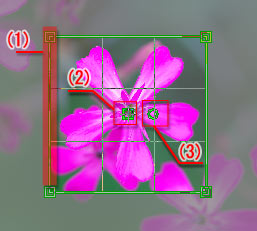 Trimming Area Handle |
[How to operate the "Setting for trimming" dialog]
- (1) "Trimming area": The following value is displayed.
- (A) Upper left axis (x,y)
 Trimming area value |
(C) Area axis (x,y)
(D) - (x,y)
- (2) "Specifying method": Select from "Free", "Image ratio", "Fixed ratio", or "Preset."
(3) "Apply": Change preview according to the parameters.
(4) "Def": Return status to the default.
(5) "Tool": Enter trimming tool mode.
(6) "Exp": All areas recorded in RAW is expanded so that they can be specified as the target (Expansion area means all areas of image information stored in RAW data, and normally a part of it is used as an effective area. Some models include black area or invalid image area).
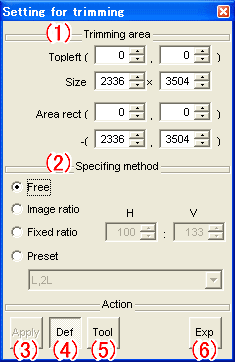 Setting for Trimming Dialog |
Expansion of trimming
The "Exp" button enables to handle all pixels including invalid pixels, which is cut out normally, and cut pixels with distortion correction, rotation, and digital shift. When pressing this button, all these pixels are displayed, and you can select the trimming area.
Invalid pixels in RAW files are also displayed. Some pixels like a noise or black area may be displayed according to the type of a camera.